Table of contents
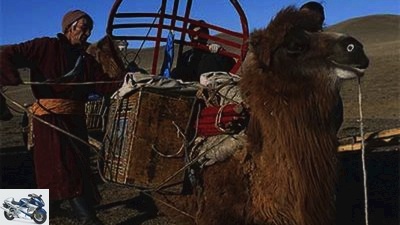
Andreas Hutter
to travel
Mongolia
Mongolia
In the first walk through the steppe
An adventurer and photographer from Switzerland sets off on a trip through Mongolia on an old Ural team? to visit a friend who lives as a nomad in the middle of the vastness of the steppe.
03/03/2006
The first meters in Ulan Bator. The old Ural team bucks like a stubborn donkey and can hardly be kept on course. The gears jump out, then all of a sudden the engine stops accelerating in the middle of an intersection, lurching at a snail’s pace over the potholes in the main road. A real horror trip through the heavy traffic of the Mongolian capital. Without a few hours of practice, I should probably not venture out into the steppe with this load. After all, my destination is 1000 kilometers west of Ulan Bator near Uliastaj in the middle of the Hangay Mountains. My friend Monkor lives there with his family. Traditional nomads whom I know from previous trips through Mongolia and have been visiting regularly since then. In the meantime I’ve spent a total of two years in this country and even learned Mongolian.
Buy complete article
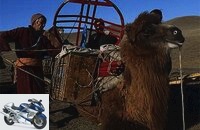
Mongolia
In the first walk through the steppe
14 pages) as PDF
€ 2.00
Buy now
I was here for the first time twelve years ago. Back then, cows dominated the streets of Ulan Bator, there were only a few cars and only two restaurants recommended for foreigners. In terms of tourism, Mongolia was almost untouched. I bought four horses and rode through the country with my girlfriend for seven months to get to know the way of life of the nomads, which fascinated me extremely. Today traffic jams are part of everyday life in the capital, pubs, discos and restaurants shape the center, tourists are preparing for off-road vehicle tours in the Gobi desert or the Altai mountains. Instead of 400,000, there are now 800,000 people living in Ulan Bator, and the country’s new problems are already evident on the outskirts. Hundreds of thousands of nomads live in run-down apartment blocks or makeshift huts who have given up their traditional life because they hoped for a better life in the city. Mostly a fatal error that ended in poverty, unemployment, crime and prostitution.
Outside of Ulan Bator, however, everything still seems unchanged. There are almost no paved roads, hardly any public transport or even a tourist infrastructure. Mongolia is still a real challenge for anyone who wants to explore the vast country on their own. The simplest method: rent an off-road vehicle with a driver. Out of the question for me because, on the one hand, it is far too expensive and, on the other hand, too isolated from the population. Anyone who travels like this is classified as a wealthy European. A horse is also eliminated for reasons of time. The countless Ural carriages in the capital then gave me the idea: Why not take it to the Hangay Mountains? I looked around the town’s market and was soon the proud owner of a blue monster with a sidecar. Cost: $ 700. Only – I had no idea about motorcycles, let alone driving them! The dealer explained the essential things to me, such as starting (very important!), Accelerating, shifting gears and braking. That was enough for now. The only thing missing was the driver’s license. Thanks to the good relations of a friend of mine with the police, I had a Mongolian driver’s license two days later – and he had 100 US dollars. Expensive but efficient.
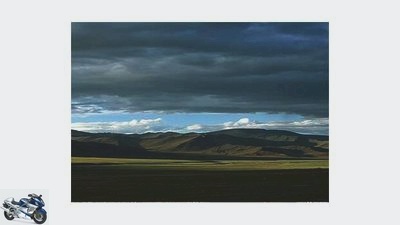
Andreas Hutter
Treeless green landscape in the Hangay Mountains.
Friends give me a goatskin coat that weighs ten kilograms as a goodbye, because in spring it hardly gets warmer than zero degrees during the day, and off we go. The Ural is also equipped with temporary cladding and wind deflectors to provide better protection against the inhospitable temperatures. Throttle and clutch cables, a few spokes, screws and spark plugs are the only spare parts I could find on board. And although I was proudly assured that the petrol station network had meanwhile been compressed to 200 kilometers, I packed a ten-liter canister into the boat to be on the safe side. For everything else I am dependent on the improvisational talent of the rural population.
The steppe begins right behind the city limits. Far and infinite. At 40 km / h we chug over a solid slope towards the west, downhill the team even swings up to a whopping 70. But after just 120 kilometers it becomes clear that an Ural was not built to cover long distances, but to be repaired on a daily basis. The engine suddenly loses its power and only manages to keep the heavy load moving in first gear. In the next village they rush to my aid – and break the Urals down into their individual parts in the middle of the dusty road. After a while it becomes obvious what I feared from the start: Nobody present has any idea about motorcycles! So a “master” has to be found, someone who understands something about this machine. Fortunately, you can quickly find a real specialist who promptly identifies a leaky valve seat as the culprit. Grind in again, no problem. It makes sense that I spend the night in this nest. A guest from far away Switzerland, who also speaks Mongolian and can talk about the world, is not so easy to let go. It’s going to be a long night with lots of vodka. Mongolian hospitality is as limitless as it is persistent.
The next day, a nomad stands at the edge of the piste looking for a ride – a point of honor in the vastness of Mongolia, even if there is hardly any space for his luggage on the motorcycle and the risk of breakdowns is not reduced by the higher weight. However, my new companion proves to be extremely helpful after just a few kilometers – when a river with a completely desolate bridge made of tree trunks appears in front of us, the gaps between the trunks are so large that our tires constantly get stuck in it. The two of us maneuver the heavy load inch by inch to the other bank.
Mongolia (Info)
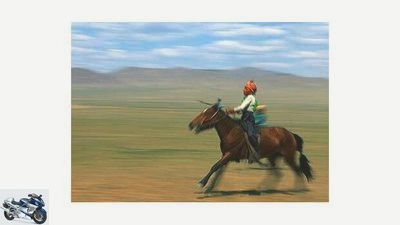
Andreas Hutter
Many Mongolian children learn to ride before they can walk.
Getting there:
Until recently, there was only one border crossing at Suchbatar south of the Siberian city of Ulan-Ude for travelers who wanted to get to Mongolia by land. In the meantime, tourists are also allowed to pass the crossing in the Altai Mountains near Tašanta in the far west of the country, which immensely shortens the journey to and from the country by land. Motorcycle transport to Mongolia is expensive and difficult to organize. The Ulmer forwarding company TLO has specialized in transports to the east and has a lot of experience with motorcycles. Information and prices: Telephone 0731/159960 (Mr. Leukert); www.tlo-gmbh.com. Flights to Mongolia start at around 800 euros. D Documents Mongolia requires a visa. Corresponding information and an application (pdf file) can be found on the website of the Mongolian embassy: www.botschaft-mongolei.de. The fee for a visa that allows a stay of up to four weeks is 35 euros. An international driver’s license and vehicle license are recommended, but a Carnet de Passage is not required.
Travel time:
The best time to travel to Mongolia is between June and September. In July and August, however, heavy rains must be expected. The consequences are partially completely softened slopes and impassable rivers, which can lead to compulsory breaks for days.
Accommodation Catering:
In the capital Ulan Bator, the needs of tourists have now been adapted quite well. Accommodation can be found in almost all price ranges. Outside of the city, on the other hand, nothing works without good camping equipment. The loneliness is deceptive, however. Whenever a tent is set up, you have to expect (nightly) visits from nomads. Something like this can be entertaining, but also exhausting, because alcohol is often involved. Despite all the hospitality, every travel guide warns against leaving any objects lying around unattended. Well-stocked supermarkets are only found in the capital, but basic foods are available in every village. The one-sided Mongolian nomad cuisine consists mainly of extremely fatty meat dishes (mostly sheep and marmots) as well as sour milk products (horse and yak milk) and hardly meets the Central European taste. In order to be prepared for all eventualities in the vastness of the country, you should always have provisions and drinking water with you for several days.
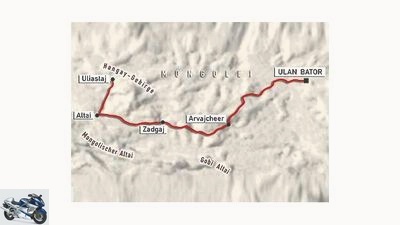
Cards: Renate Maucher
Organized tours:
The tour operator “Extratour” offers several guided motorcycle tours with an escort vehicle through Mongolia. You will ride a Yamaha XT 600, and depending on the route you will be on the road for two or three weeks. Prices start at 2780 US dollars (around 2330 euros), plus the amount for the flight. Info: Telephone 06185/818212; www.mongolei.com.
The motorcycle:
In hardly any other country in the world are you on your own as in huge Mongolia, which has little or no infrastructure. Mongolians may be hospitable and talented at improvising, but they cannot fix defects in modern motorcycles. A simple and robust enduro with a range of at least 350 kilometers is best, as is a well-stocked spare parts and tool package. Many very useful tips for the correct preparation of such a trip are provided by “The Handbook for Motorcycle Travel” by Klaus Demel (Motorbuch Verlag, 19.90 euros) and “Motorcycle Travel Between Vacation and Expedition” by Thomas Trobmann (Reise Know-How, 22.50 Euro)
Orientation / literature:
Satellite navigation may be a gimmick for many, but in Mongolia it is essential to stay on course. Touratech’s travel professionals are specialists in equipment, software and the corresponding handlebar mounts, phone 07728/92790; www.touratech.de. The best cards come from the stocks of the Russian military. The sheets in the scales of 1: 200,000 and 1: 500,000 cost 15.95 euros each. Information: Darr Expeditionsservice GmbH, phone 089/282525; www.daerr.de. If you want to travel through the country on your own, you should not do so without the excellent travel guide “Mongolia” from Reise Know-How. The 408-page book by the team of authors Fred Forkert and Barbara Stelling is full to the brim with lots of current tips and information. Price: 22.50 euros.
Mongolia (2)
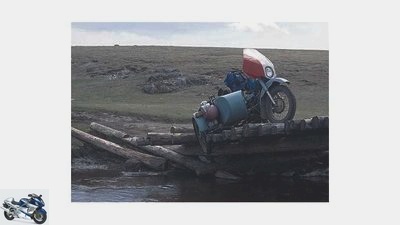
Andreas Hutter
A bridge that cannot be tensioned.
The next river doesn’t make it that easy for us: There is only one ford on it, and we bubble bravely and with momentum into the half-meter deep water. What a modern enduro would enjoy as an after-work party becomes an impassable obstacle for the Urals: They die right in the middle of the river. Even in twos we don’t have a chance to push her over the stony ground to the bank. But suddenly a rider appears out of nowhere. Without saying many words, the nomad attaches a rope to the frame of the machine and violently spurs the horse. We also pull and push as hard as we can and actually bring the Urals ashore. However, it no longer starts to die. The engine probably drew in buckets of water before it died. My companion explains to me that he knows someone in the next village who has the same vehicle. Together we drag the Urals to the fortunately nearby settlement. Indeed, the Ural owner there is ready to unscrew the necessary spare parts from his motorcycle and sell it to me.
After four days I am still traveling with a companion. I had often asked my passenger where they were actually going. And he always got the same answer: “Yes, exactly in that direction!” When we finally parted at a major intersection, he admits that we had reached his actual destination on the first day after around ten minutes by car. But he didn’t want to miss this rare opportunity to finally get around. We say goodbye like old friends.
Again and again I get stuck with various defects. Once I rammed a boulder with the right cylinder, which penetrated the valve cover and damaged the exhaust valve in the process. Another time – because of constant screwing in and out – the spark plug threads have to be renewed, and spokes break almost every day. And it always goes on somehow. Now I can remove and install the engine on my own. The Mongols’ talent for improvisation and their unshakable happiness and confidence are a reliable factor.
After a two-week drive I finally get to Uliastaj and immediately start looking for Monkor, who doesn’t know about my arrival. I find him in front of his house, where he and his family spend the harsh winter months. At first I am scared. He seems to have aged many times over in recent years. I will soon find out the cause. Like hundreds of other families in the region, his family was also the victim of a snow storm in 1999, in which over a million animals died in this province – and the nomads were thus deprived of their livelihoods. Monkor’s family also lost almost all of their horses, cows, and sheep. So that the family can survive and send the two daughters to school, Monkor’s wife Batna now works as a seamstress in town. His two sisters, on the other hand, were luckier. Their camps were around 150 kilometers to the west, their herds were almost intact. This is how they could help Monkor’s family. Without their strong cohesion, many nomad families would have had to give up their traditional way of life.
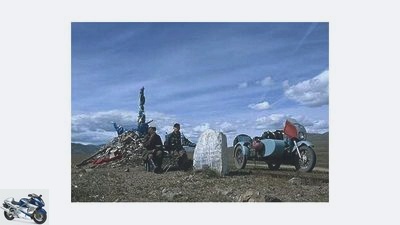
Andreas Hutter
A table and a bench mark a “rest stop”.
Together we drive out to his campsite near the city, on which a handful of bright round tents made of felt, so-called gers, have been erected. The whole family rushes over to greet them immediately, Airag makes the rounds, fermented mare’s milk, which tastes terrible, but is nutritious and rich in vitamins and underlines the joy of seeing you again. Even a mutton is slaughtered in my honor. Monkor tells how his situation has changed and he is starting to worry about the future. “For years we have observed that less and less rain falls in the summer months. As a result, the grass no longer grows fast enough and the animals cannot find enough food. ”Without fat pads, they cannot survive the tough winter, which for many months with lots of snow, violent storms and temperatures of up to minus 30 degrees in the Mongolian steppe arctic living conditions.
Early the next morning we ride to the herds. I learn how tough even the first half of spring was this year. “At night, temperatures were as low as minus 15 degrees. Many streams and rivers were also completely dry, so we
Had to fetch huge chunks of snow on ox carts from the mountains so that we had any water at all. ”Business was bad, the prices for dairy products as well as for sheep, camel and yak wool had fallen sharply. In addition to horses and sheep, Monkor’s family also breeds cashmere goats. “You can only earn some money with their wool.” In order to survive, the nomads are dependent on ever larger herds of livestock. “Overgrazing,” explains Monkor, “has now become a serious problem in huge Mongolia as well.”
Growing vegetables is now another mainstay. Monkor says he bought an irrigated field near the city to grow potatoes, carrots and cabbage. Not an easy decision for a nomad whose family has been raising cattle for generations and has no sedentary lifestyle – fieldwork is seen as a great humiliation in Mongolia. Still pulls
The family now goes to the field almost every day because they urgently need the additional income. In the next few days, the Ural will be used as a reconnaissance and transport vehicle. Monkor is obviously having fun sitting next to me in the wind and proudly presenting itself to the neighbors. Together we are looking for a new storage place and bring wood, wool and meat to his relatives who live scattered in the vicinity. And who, at least it seems, have long since accepted me as a family member.
I took the route from Ulan Bator to Monkor’s camp site many times under the wheels of the Urals during four other journeys. My record is four days in the saddle from sunrise to late at night. The rapid cut of around 20 kilometers per hour could only be achieved because icy temperatures had frozen the ground and made it easy to drive on. The bottom line was 14,000 kilometers. To my astonishment, the Urals ran the last 3500 of them almost without a breakdown, so that I finally handed the blue monster over to my Mongolian friends with a clear conscience.
Related articles
-
to travel Uganda Uganda Encounters in the bush Up until ten years ago, there was a cruel civil war in Uganda. With his Enduro, Hartmut Ponitz has now…
-
Photos: Obert to travel South and Central Asia South and Central Asia Around the roof of the world It’s hard to believe, but the idea came spontaneously…
-
to travel Nepal Nepal Once limit value and back With a 500 Enfield to the eight-thousanders on earth. A journey between wooden sheds and pagoda temples…
-
Schulz to travel Motorcycle world tour Motorcycle world tour 50,000 kilometers home Many dream of the great journey, the trip of a lifetime. At some…
-
Travel: Halfway around the world by motorcycle
archive 15th pictures Hofmann 1/15 Steven’s Way of Life: The twelfth part takes Steven over Nepal’s bridges, mountains and valleys. Hofmann 2/15 The…
-
Daams to travel Montenegro Montenegro Phoenix from the ashes The southernmost fjord, the deepest canyon and one of the last primeval forests in Europe ??…
-
On the smallest paths through Germany, part II
Johann to travel On the smallest paths through Germany, part II On the smallest paths through Germany, part II Is it going to the Baltic Sea somewhere??…
-
Endurance test interim results of the BMW F 800 S
Artist motorcycles Endurance test interim results of the BMW F 800 S Endurance test interim results of the BMW F 800 S Noticeably inconspicuous The F 800…
-
Tips for buying used motorcycles with over 100,000 kilometers
Herder 21 pictures Lohse 1/21 Aglasterhausen, Ducati ST2, EZ 4/2002, 121,766 km. Lohse 2/21 Actually a tragic case. Ducati is building a famous tourer…
-
to travel Baltic states Baltic states Different than expected Beaches like on the Mediterranean, cappuccino like in Italy and magnificent buildings that…